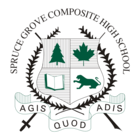Life, Academic, Work Skills (LAWS) provides an alternative classroom program for students with mild/moderate to severe cognitive delays and a significant impact on their adaptive functioning. Our focus is on functional literacy and numeracy skills that are adapted or modified learning outcomes from the Alberta Programs of Study. When students enter the program competence is presumed. Literacy and numeracy are identified as life skills and a comprehensive approach is utilized in daily instruction by ensuring all students have a voice, a way to write, a way to read and a way to engage. Additional key areas of focus are social/emotional regulation, functional skills, communication skills, health and well-being, social skills, job preparation and community work experience.
Much of the learning in LAWS occurs through community work placements. LAWS students are also involved in many community activities and outings to further develop their skill, and have access to adaptive technology to gain more independence. Sensory needs can be met through the use of an on-site sensory room.
Each classroom offers a team approach consisting of parents, teachers, Inclusive Education Leads (IELs), administrators and educational assistants. Supportive services from occupational therapy, physical therapy, speech-language therapy, blind-low vision, deaf/hard of hearing, and district facilitators are available to consult with staff to address specific student needs and assist with programming decisions. We work to develop independence and autonomy so students can function effectively and thrive within the educational environment and the community, as they become resilient learners who positively affect the world.
At the successful completion of their Grade 12 year, students are awarded a High School Certificate of Completion. Upon completion of this program, students will have a variety of opportunities to meet their individual goals and meaningfully contribute to their community.
To be eligible for this program, individual education plans and relevant assessment must identify a need. Placement in this program is through recommendation by the student's community school and in conversation with the receiving school, parents and Student Services.
